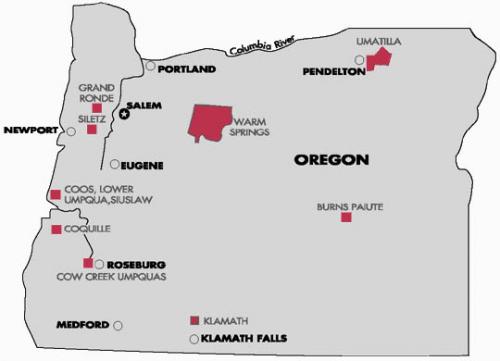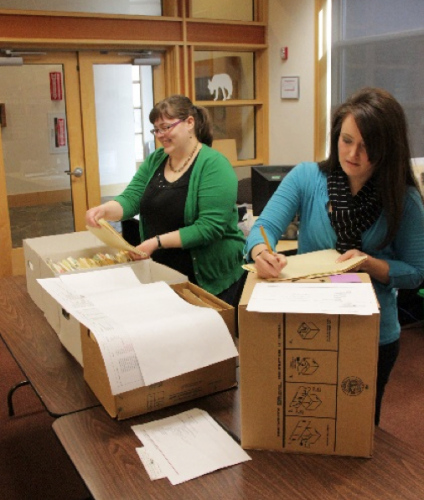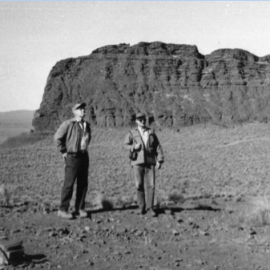In the fall of 2012, I began my tenure as the University Historian and Archivist at the University of Oregon Special Collections and University Archives.
My main duties include the curation and collection development of permanent records of the university, overseeing our instruction program, and serving as an advisor on cultural heritage archives.
When I began this position, I was eager to learn more about a project that I had heard about at a conference, involving the faculty papers of Theodore Stern, a well-known anthropologist who worked with and studied Oregon’s tribal communities throughout the later part of the twentieth century. I was pleased to find out that some initial work had been undertaken by my predecessor, and was excited to embark on a full-scale collaborative stewardship project with tribal communities represented in the records. However, before doing so, I had a lot of work to do including learning more about Stern and his research, the history surrounding the donation of his records, what was in his collection of records, why the records were important to Oregon’s tribal community, and most importantly, developing methods and strategies for collaborative stewardship of the records with the tribal communities represented.
Stern, His Research, and the Collection
Theodore “Ted” Stern received a Ph.D. in 1948 from the University of Pennsylvania with a dissertation on “The Rubber-ball Games of the Americas.” He then joined the faculty of the Department of Anthropology at the University of Oregon in Eugene, where he served for thirty-nine years, from 1948 to 1987. He was a leading authority on the linguistics and anthropology of the Klamath and Nez Perce people of the eastern Oregon plateau, with research and publications in ethnohistory, folklore, linguistics, archaeology, ethnomusicology, anthropology, and Native history. Stern spent many summers at the Umatilla, Nez Perce, and Klamath Reservations, studying their languages and cultures. He studied and documented how the Tribes addressed changes that came with the signing of the Treaty of 1855, the reduction of ancestral territory and the creation of the reservation system. He was one of a handful of scholars who conducted in-depth research on the Confederated Tribes of the Umatilla Indian Reservation (CTUIR) in the mid-1900s. Dr. Stern spent two extended periods of time on the reservation in 1953 and 1954, and then returned periodically over the next decade and a half. He also spent four summers living with members of the Halfmoon family, who regard him fondly to this day.
From Stern’s research he produced two key volumes on the history of the Umatilla and Nez Perce tribes—Chiefs and Chief Traders (1992) and Chiefs and Change in the Oregon Country (1996), a finalist for the Oregon Book Award. He also authored The Klamath Indians (1970) and "Cayuse, Umatilla, and Walla Walla," which appeared in volume 12 of The Handbook of North American Indians (1998).
Before his passing in 2005, Stern donated his faculty and research papers to the University of Oregon Special Collections and University Archives. The papers contain voluminous notes about tribal languages, myths, and genealogies and, for the papers regarding Umatilla, include correspondence, field notes, research notes, informant summaries, photos, negatives, genealogies, and drawings. Before his passing, Stern made clear that he wanted to ensure that the Umatilla tribal community would have full access to the collection for research and study, especially as many had previously never had access to his records and research. This would be an exciting opportunity for tribal family members who Stern worked with and interviewed for his research. However, because the collection also contained significant items with possible privacy concerns, including informant surveys that included very personal information about families still living, the repository and CTUIR needed to establish detailed guidelines and protocols for access. This began the discussion of how to develop a collaborative stewardship project for this collection to ensure that the access issue would be resolved, and that curation would be handled appropriately.

CTUIR and the Tamástslikt Cultural Institute
Since this project focuses on The Confederated Tribes of the Umatilla Indian Reservation, it is important to point out some basic and historical facts about the tribal community. CTUIR is made up of three tribes—the Cayuse, Umatilla and Walla Walla tribes. When the leaders of the three tribes signed a treaty with the United States in 1855, they ceded 6.4 million acres of homeland in what is now northeastern Oregon and southeastern Washington. The 172,000-acre Umatilla Indian Reservation, almost half of which is owned by non-Indians, includes significant portions of the Umatilla River watershed. Today the confederation, united under a single tribal government adopted in 1949, numbers over 2,800 members (2011). The Umatilla are governed by a Board of Trustees composed of nine members elected by the General Council. Tribal headquarters are located in Mission, just outside Pendleton, Oregon.
CTUIR is also home to the Tamástslikt Cultural Institute (TCI), the tribal museum and cultural institute opened in 1998 and is dedicated to the culture of the Cayuse, Umatilla, and Walla Walla tribes. The main permanent exhibition provides a detailed history of the culture of the three tribes and of the larger reservation. The second hall features temporary exhibitions, including ones on Native American art, craftwork, history and folklore related to the tribal community. It is the only Native American museum along the Oregon Trail.
The Ted Stern Collaborative Stewardship Project
As previous noted, some work on the Stern collection had already begun before my arrival. In 2011, TCI Research and Collections Manager, Malissa Minthorn, proactively reached out to the head of our department, James Fox, to begin initial conversations about possible next steps for the Umatilla portion of the collection. At that point TCI was very eager to begin researching and reviewing many of the materials in the collection. Since Eugene (where the University of Oregon is located) is such a long drive from Umatilla (approximately 5 hours), the UO Special Collections and University Archives agreed to loan to TCI the portion of the collection relating to Umatilla, which totaled approximately 13 record center boxes.
When I arrived in the fall of 2012, I was eager to move forward with next steps and to begin planning the overall project with TCI staff. The plan evolved over a series of conference calls and on-site consultations. The initial idea was to have an employee of TCI or a community member process (ie. organize and describe) the Umatilla portion of the collection. However, the challenge was finding funding to support the organization and processing of the collection by TCI. Consequently, TCI directly applied for and successfully received a small grant from the Oregon Heritage Commission. Although the grant was very small, it would at least fund someone on a part-time basis to begin the work.
Through our consultations, we quickly realized that the project should proceed in phases to ensure that the work would be manageable, thus we developed a detailed action plan. The first phase would include a TCI staff member processing the collection by re-housing, organizing, and conducting a high-level inventory, and then UO would bring everything together to publish a complete finding aid, or guide to the collection. The second phase would be to apply for additional funding for digitization. Finally, the third phase would be to hold outreach events with the Umatilla tribal community, including a symposium at TCI about Stern and his collection.
 We are currently still in the first phase of this project, but we have made considerable progress. When I first began the project we started with conference calls, but I knew that in order to get a better understanding of the collection, tribal community, museum, and staff, I would need to conduct on-site consultations. I visited twice, once in the fall of 2012 and once in spring 2013. The first initial meeting was intended to meet the key stakeholders, determine goals and garner consensus about the project, detail staff concerns, and to familiarize myself with the museum. The second on-site visit came after we established our action plan for phase one, and included hands-on processing training for the TCI staff member, Katie Barry, who was hired to conduct the processing work. Although TCI has varied archival collections, they had not processed a collection of this size and scope. Thus, they asked me to come back and provide detailed training on how to organize, arrange, and conduct basic preservation work on the collection. Once this training was completed, they began actually organizing and processing the collection. So far they have been able to organize and inventory over 50% of the collection.
We are currently still in the first phase of this project, but we have made considerable progress. When I first began the project we started with conference calls, but I knew that in order to get a better understanding of the collection, tribal community, museum, and staff, I would need to conduct on-site consultations. I visited twice, once in the fall of 2012 and once in spring 2013. The first initial meeting was intended to meet the key stakeholders, determine goals and garner consensus about the project, detail staff concerns, and to familiarize myself with the museum. The second on-site visit came after we established our action plan for phase one, and included hands-on processing training for the TCI staff member, Katie Barry, who was hired to conduct the processing work. Although TCI has varied archival collections, they had not processed a collection of this size and scope. Thus, they asked me to come back and provide detailed training on how to organize, arrange, and conduct basic preservation work on the collection. Once this training was completed, they began actually organizing and processing the collection. So far they have been able to organize and inventory over 50% of the collection.
At very top; Stern in the field (on the right), ca. 1970s; above left, Katie Barry (left) and Jennifer O’Neal (right) processing the Stern collection at TCI, Spring 2013. All images courtesy J. O'Neal, used with permission.
We are still determining the best method for handling privacy issues regarding the informant surveys mentioned earlier. As an interim policy, all requests for access to these specific records are fielded through the Research and Collections Manager, Malissa Minthorn, who is also a tribal member. We will of course develop a more formal policy as we move forward with the final processing of the collection, however we are respecting the wishes of the CTUIR tribal community who serve as the experts on these records.
Next Steps and Lessons Learned (thus far)
Although we are only into the first phase of the project, we have already learned some important lessons. Key to this project has been the flexibility and patience of our team and institutions. Both repositories (TCI and UO) were completely committed to the idea of the project, however, figuring out how to actually make it happen took some creativity and planning, especially in terms of funding and the length of time needed for completion. In addition, this is only one of many projects we are all working on so being flexible about the timeframe, and realistic about what we can and cannot accomplish has been key.
In addition, while challenges related to distance, varied perspectives, and preconceptions about the project are inevitable, it is important to keep an open-mind to all opportunities for potential growth for both sides involved. For example, TCI reached out to me to provide them with some basic hands-on archival processing training relevant to the collection – something we hadn’t initially planned. However, I was thrilled to work with them on this aspect of the project.
This project is being noticed by other colleagues throughout the region, and Katie and I will be presenting a session about the project at the annual Northwest Archivists conference in Spokane, Washington May 29-31, 2014.
The UO Libraries is delighted that we have been able to embark on this project with the TCI staff in the CTUIR tribal community. We feel privileged that we can honor Ted Stern’s legacy and give new life to his research and records. The overall goal is to share the collection with the CTUIR tribal community, connect them with the records that hold their tribal history, and add their tribal perspective and knowledge.
Jennifer O'Neal is the Corrigan Solari University Historian and Archivist at the University of Oregon Libraries, Special Collections and University Archives, and an IPinCH Associate. Jennifer is a member of The Confederated Tribes of Grand Ronde.







Comments
Stern Collection
Stern Collection